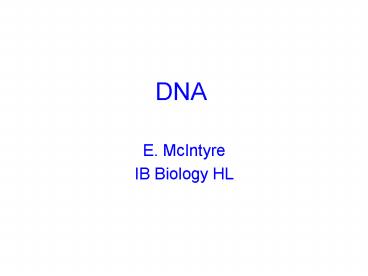DNA - PowerPoint PPT Presentation
1 / 42
Title: DNA
1
DNA
- E. McIntyre
- IB Biology HL
2
DNA is the Genetic Material
- Therefore it must
- Replicate faithfully.
- Have the coding capacity to generate proteins and
other products for all cellular functions. - A genetic material must carry out two jobs
duplicate itself and control the - development of the rest of the cell in a specific
way. - -Francis Crick
3
Watson Crick in action
4
Models for DNA replication
- 1) Semiconservative model
- Daughter DNA molecules contain one parental
strand and one newly - replicated strand.
- 2) Conservative model
- Parent strands transfer information to an
intermediate, then the - intermediate gets copied. The parent helix is
conserved, the daughter - helix is completely new.
- 3) Dispersive model
- Parent helix is broken into fragments, dispersed,
copied then - assembled into two new helices. New and old DNA
are completely - Dispersed.
5
MODELS OF DNA REPLICATION
(a) Hypothesis 1
(b) Hypothesis 2
(c) Hypothesis 3
Semi-conservative replication
Conservative replication
Dispersive replication
Intermediate molecule
6
Meselson and Stahl
Semi-conservative replication of DNA
7
(No Transcript)
8
The families of nitrogenous bases
9
DNA Replication
- Since DNA replication is semiconservative,
therefore the helix must be unwound. - John Cairns (1963) showed that initial unwinding
is localized to a region of the bacterial
circular genome, called an origin or ori for
short. - DNA replication is semiconservative. Each strand
of both replication forks is being copied. - DNA replication is bidirectional. Bidirectional
replication involves two replication forks, which
move in opposite directions
10
Evidence points to bidirectional replication
11
The Enzymes of Replication
12
A 3 hydroxyl group is necessary for addition of
nucleotides
13
DNA Polymerase contains a Proofreading subunit
Accuracy of DNA polymerases is essential. -Error
rate is less than 1 in 108
14
Proofreading by DNA polymerase
15
DNA Exonuclease
16
DNA replication is semi-discontinuous
Continuous synthesis
Discontinuous synthesis
17
Proteins the Replication Fork
18
Protein complexes of the replication fork DNA
polymerase DNA primase DNA Helicase ssDNA binding
protein Sliding Clamp Clamp Loader DNA Ligase DNA
Topoisomerase
19
DNA primase synthesizes an RNA primer to initiate
DNA synthesis on the lagging strand
20
Replication of the Lagging Strand
21
DNA ligase seals nicks left by lagging strand
replication
22
DNA helicase unwinds the DNA duplex ahead of DNA
polymerase creating single stranded DNA that can
be used as a template
23
DNA helicase moves along one strand of the DNA
24
ssDNA binding proteins are required to iron out
the unwound DNA
25
ssDNA binding proteins bind to the sugar
phosphate backbone leaving the bases exposed for
DNA polymerase
26
DNA polymerase is not very processive (ie it
falls off the DNA easily). A sliding clamp is
required to keep DNA polymerase on and allow
duplication of long stretches of DNA
27
A clamp loader complex is required to get
the clamp onto the DNA
28
Lagging strand synthesis
29
(No Transcript)
30
The supercoiling ahead of the fork needs to be
relieved or tension would build up (like coiling
as spring) and block fork progression.
31
Supercoiling is relieved by the action of
Topoisomerases
Type I topoisomerases Make nicks in one DNA
strands Can relieve supercoiling Type II
topoisomersases Make nicks in both DNA strands
(double strand break) Can relieve supercoiling
and untangle linked DNA helices Both types of
enzyme form covalent intermediates with the DNA
32
Topoisomerase I Action
33
Topoisomerase II Action
34
Topoisomerase II Action
35
Topoisomerases as drug targets
Because dividing cells require greater
topoisomerase activitydue to increased DNA
synthesis, topoisomerase inhibitors are used as
chemotherapeutic agents. e.g. Camptothecin --
Topo I inhibitor Doxorubicin -- Topo II
inhibitor These drugs act by stablilzing the
DNA-Topoisomerase complex. Also, some
antibiotics are inhibitors of the
bacterial-specific toposisomerase DNA gyrase
e.g. ciprofloxacin
36
DNA is replicated during S phase of the Cell Cycle
37
In S phase, DNA replication begins at origins of
replication that are spread out across the
chromosome
38
Each origin of replicaton initiates the formation
of bidirectional replication forks
39
Origins of replication are strictly controlled so
that they fire only once per cell cycle
Errors lead to over replication of specific
chromosomal regions. ( gene amplification) This
seen commonly in cancer cells and can be an
important prognostic indicator. It can also
contribute to acquired drug resistance.
40
Errors of DNA Replication and Disease
The rate of misincorporation of bases by DNA
polymerase is extremely low, however repeated
sequences can cause problems
In particular, trinucleotide repeats cause
difficulties which can lead to expansion of these
sequences. Depending where the repeat is located
expansion of the sequence can have severe effects
on the expression of a gene or the function of a
protein.
41
Several inherited diseases are associated with
expansion of trinucleotide repeat sequences.
42
Have no fearits efficient!! Check out these
stats
Polymerase III Its fast up to 1,000 dNTPs
added/sec/enzyme Its highly processive
gt500,000 dNTPs added before dissociating Its
accurate makes 1 error in 107 dNTPs added, with
proofreading, this gives a final error rate of 1
in 1010 overall.































